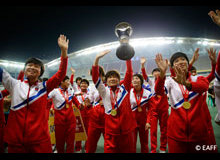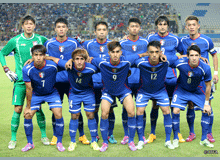The AFC U-23 Championships also served as the Olympic qualifiers. Sixteen nations were divided into a league consisting of four groups, with China PR joining host country Qatar’s Group A, and Japan placed in Group B with the DPR KOREAorea. Korea REP was placed in the toughest group – Group C, which contains Iraq and Uzbekistan, both known for their formidable U-23 teams.
China PR faced off against Qatar on the opening day of the Championship, and got off to a good start when Liao Lisheng (midfield, 10) gave his team the lead with a skilful free kick. However, the Chinese side was unable to repel the host country’s potent attacks, conceding three goals and a victory in the first match. In China PR’s following match, against Syria, midfielder Liao Lisheng once again scored the opening goal. A penalty kick awarded to the Syrian squad, however, brought the score to 1-1, before two more goals for Syria settled the game with another loss for China PR.

The I.R. Iranians scored the first goal in the China PR vs I.R. Iran match. China PR was quick to bring out its distinctive style: the wing offensive. Chang Feiya (midfielder, 19) cracked an expert shot, tying the game at 1-1. However, holes started to emerge in the Chinese defense from that moment onward, allowing the I.R. Iranian side to steal two more goals. Though a penalty kick toward the end of the game saw China PR narrow the score to a difference of one goal, the Chinese were unable to crack open the persistent I.R. Iranian defense, leading to their third consecutive loss.
These past few years have seen the Chinese national football team invest heavily in developing a strong generation of football youth. The three Middle Eastern teams they faced were not able to completely overwhelm the squad. However, despite the impressive individual capabilities of each individual player, team focus and resilience remain as future problems to be resolved.
Japan and the DPR Korea came head to head in the first match. Previous encounters between the two teams had seen the DPR Korea dominate in a penalty shootout in the quarter finals of the 2014 AFC U-19, making this match a test for both squads. In the opening five minutes of the match Ueda Naomichi (defense, 5) connected with a corner kick, allowing Japan to steal the first goal and, with sustained efforts at resisting some sharp DPR Korea attacking, take away a 1-0 victory in their first match.
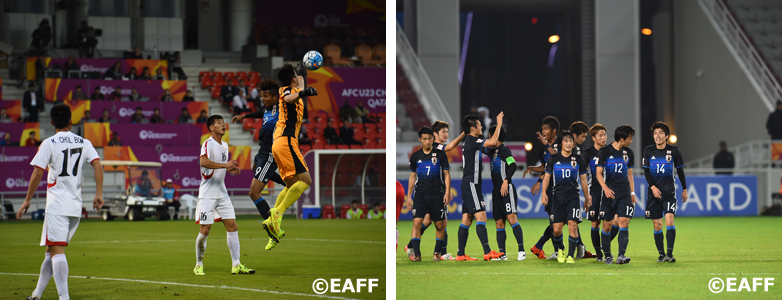
In their next game, against Thailand, the Japanese manager Teguramori went ahead with his plan of changing six players on the starting line-up. Though the Japanese squad began the game under pressure by the technical offensive work of the Thais, they gradually gained control of the game. Piling on their attacks saw them secure a 4-0 victory. Since the DPR Korea vs Saudi Arabia match ended in a 3-3 draw, Japan did not have to wait for the third match before discovering they had made it through the group stage. Large changes were also made to Japan’s starting line-up in their match against Saudi Arabia, while a 2-1 win in that game saw Japan through to the quarter finals on a high.
The DPR Korea, who had performed admirably in their heated battle against Saudi Arabia, played Thailand for a place in the quarter finals. The side managed to take the lead twice, through a header by Kim Yongil (midfielder, 9) and a volley shot by Yun Il-gwang (midfielder, 14), though the team’s flanks were compromised, and the match ended in a 2-2 tie. However, as Saudi Arabia had lost to Japan, DPR Korea was placed second in the group and thus seeing itself being placed in the quarter finals.
In the quarter final match between host country Qatar and DPR Korea, a foul that saw Hong Jin-song (defense, 3) topple an opponent gave Qatar a free kick and the lead. However, some tight defense work prevented the ‘talent corps’ Qatar from scoring another goal, whilst the DPR Korea initiated repeated counterattacks. In additional time, So Kyon-jin (midfielder, 20) scored on a brilliant free kick from a left-leaning angle, sending the match into extra time. However, some skilful and speedy offensive work in the opening minutes of the first half of extra time saw the side’s defences break down once again. The DPR Korea was unable to strike back, and the game ended with a loss.
The DPR Korea was notable for its characteristic organisational strengths, which serves as the team’s foundation, and their counterattacks and accurate passing stood out during the Championship. Though the absence of the team’s ace, Park Hyonil, must have had a detrimental effect on the squad, shining stars could be found in Kim Yong (midfielder, 9), who had scored two goals and put on a good show for the spectators. Also on the squad were national team members such as Jang Kuk-chol (defense, 5), and one can see an increasing number of footballers from this squad eventually becoming permanent members of the A-team.

The kings of Group B Japan faced a fiery match against I.R. Iran in the quarter finals. I.R. Iran, with its strategy of sending forth long passes and breaking up the field, Japan had two attackers in post positions to deal with. Tireless set ups by Nakajima Shoya (midfield, 10) from the left hand side of the field failed to give Japan a goal.
I.R. Iran was in a more favorable position. However, the score remained 0-0 into extra time, when Japan used its advantage in stamina in the form of a cross from Muroya Sei (defense, 12) to Toyokawa Yuta (forward, 14), who had been substituted into the game earlier, for a long-awaited first goal. The goal allowed Japan to find its footing, with Nakajima Shoya (midfield, 10) scoring on two spectacular mid-range shots during the second half of extra time, giving the Japanese squad a great victory of 3-0.
The Japanese squad now faced Iraq in the semi-finals for a place in the Olympics. Japan was faced with an opponent it had lost to many times in the past in the U-23 category, and though the squad’s inferiority in physical contact play was put on display, Suzuki Musashi (forward, 9) managed to break through a momentary gap in the Iraqi squad. This allowed Kubo Yuya (forward, 11) to free himself from the defensive line and steal the first goal. However, an ill-handled Iraqi corner kick in the 43rd minute brought the score back to a draw.
After that both teams were unable to capitalize on their opportunities, and as it seemed more and more likely that the match would go into extra time a goal kick that had been picked up by Harakawa Riki (midfield, 7) was turned into a phenomenal mid-range shot that gave Japan a place in the finals and a spot in the Olympics.

In Group C Korea REP played a tough game against an ever-growing Uzbekistan. However, a rather fortunate handball gave the Korean side a penalty kick. This was coolly scored by Moon Chang-jin (midfield, 7), which lead to a second goal for Moon Chang-jin from a cross that came about as Korea REP broke through the Uzbekistan line. Though the team would go on to concede a goal, a red card for the opposing team helped Korea REP end with a win and three points on the tables.
In their next game, against Yemen, Korea REP was able to score a tremendous victory with a record five goals, though, as was the case with the Iraqi squad, the Koreans tied in their third game after winning their first two matches. However, the goal difference between Korea REP and other squads saw the team lead the group and progress to the quarter finals.
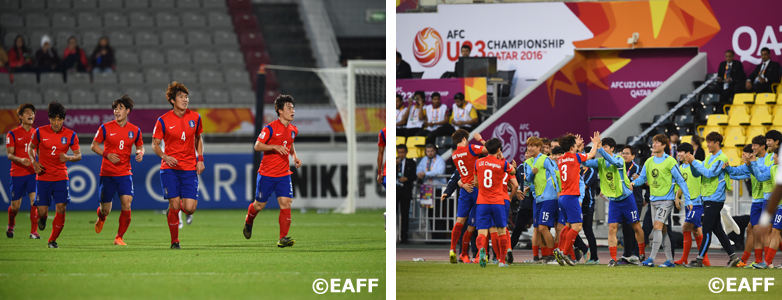
Korea REP faced Jordan in the quarter finals. The persistence of the latter, which had won its way to the top of Group D, presented problems for the Korean squad. However, in the 23rd minute Moon Chang-jin (midfield, 7) scored, and the point that Korea REP had gained was defended to the very end, resulting in a spot in the semi-finals for the Korean team.
The semi-final match against host country Qatar witnessed Ryu Seong-woo (midfield, 10) react to a long pass that the Qatari goalkeeper had rushed out to stop prior to it being sent into the back of the net by Ryu. However, toward the end of the match the fatigued team saw a number of its players suffer from strained ankles. Qatar seized the opportunity to score an equalizer, and risky exchanges ensued. However, an opportunity on a counterattack saw six players before the goal, attacking with all their might – a feat that bore fruit in a goal scored by Kwon Changhoon (midfield, 22). Following this came a third goal for the team, scored by Moon Chang-jin. Manager Shin Tae-yong’s team is a squad that is grounded in high footballing technique. It was able to confirm its customary strength in a close match and secure a spot in what will be its eighth competition – the Olympics.
Expectations were high that the Japan vs Korea REP finals were to put the pride of both squads on the line. Until partway through the second half the Korean team seemed to dominate the Japanese side. A fifth Championship goal for Kwon Changhoon (midfield, 22) gave his team the first goal of the match, and the Japanese squad subsequently adjusted its formation from a 4-4-2 to 4-3-3 setup. Despite this, Jin Seong-uk (forward, 18) managed to score an extra goal for Korea REP, and victory for the team seemed a foregone conclusion. However, the fleet wildcard Asano Takuma (forward, 16) propelled Japan into a counteroffensive, and in the 67th minute a pass from Yajima Shinya (midfield, 21) found Asano Takuma, who stole away from the defenders in a timely manner to score Japan’s first goal.
A minute later a cross from Yamanaka Ryosuke (defense, 6) now finds Yajima Shinya’s head for an equalizer. Then in the 81st minute a clumsy clearance after a counterattack by the Korean squad was claimed by Nakajima Shoya (midfield, 10), who gave the ball to Asano Takuma, who had by then broken through the defense line for a one-on-one confrontation with Korean goalkeeper Kim Dong-jun (goalkeeper, 1). This was handled with complete calm by the Japanese forward, who put the ball into the net for a table-turning goal, giving the Japanese squad a dramatic victory and the title of Asian champions.
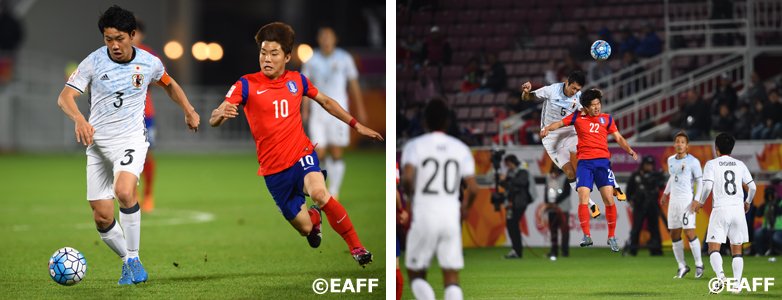
Though Japanese victors were not given high hopes prior to the Championship, their strengths as a team solidified during the course of their pre-competition camp, and the introduction of a ‘hero of the day’ through the cycling of new players every match allowed the side to win all six of its games. Some claimed that Republic of Korea had a squad of relatively lower quality when compared with its past teams.
However, throughout the competition the team was able to display its highly technical football and coordination, tapping into its resilience as a squad at the most important moments. In the finals the outcome for the two EAFF members was settled.
However, over the past half year the team has seen further growth, and its ability to grasp a ticket to the Olympics gives it, along with the Iraqi squad (which finished third), a chance to inspire high expectations in many of those hoping to see its rapid progress as a representative of Asian football.
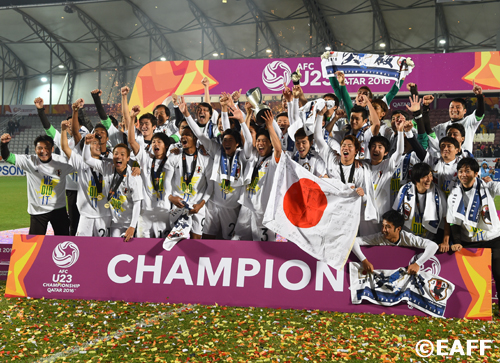
EAST ASIAN FOOTBALL FEDERATION

COLUMN

Review of the AFC U-23 Championship Qatar 2016 – the Fight for Three Olympic Slots
+
10passion
RECOMMEND
- 10MA TOPICS! [JAPAN FA] New players provide new options for Nadeshiko Japan in sweeping victory over Chinese Taipei - EAFF E-1 Football Championship 2019
- 10MA TOPICS! [HONG KONG FA] Hong Kong set to lock horns against Japan in EAFF E-1 Football Championship 2019 Final
- 10MA TOPICS! [JAPAN FA] [EAFF E-1 Championship] Double delight for Japan


